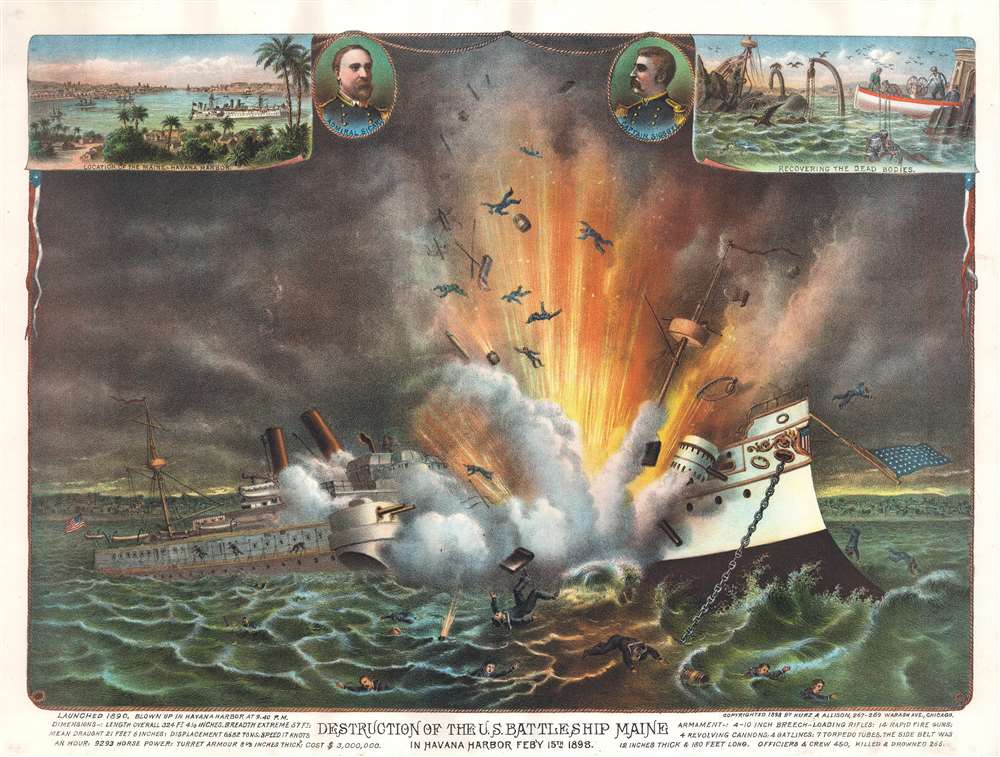This item has been sold, but you can get on the Waitlist to be notified if another example becomes available, or purchase a digital scan.
1898 Kurz Allison View of the Destruction of the Battleship Maine, Havana, Cuba
DestructionMaine-kurzallison-1898
Title
1898 (dated) 19.75 x 26 in (50.165 x 66.04 cm)
Description
Sinking of the Maine
To this day, no one really knows what happened with the U.S.S. Maine. The Maine, under Captain Charles Dwight Sigsbee (1845 - 1923) was sent to Havana on January 25 to protect American interests during the violent Cuban War of Independence (1895 - 1898). She was a powerful ship, an armored cruiser with two gun turrets and steam propulsion. Commissioned in 1895, the Maine represented the pinnacle of American naval engineering. The ship exploded without warning at 9:40 PM on February 15, 1898, killing 75% of the crew - Sigsbee and most of his officers, at the opposite end of the ship from the explosion, survived. Four separate military investigations followed with limited conclusions, but in a triumph of yellow journalism, the American news media claimed a Spanish mine destroyed the ship - using it as a catalyst to further American support for Cuba's anti-colonial insurgency. Later investigations suggest that the bituminous coal used to fuel the Maine gave off some explosive methane that spontaneously ignited, triggering a more powerful secondary explosion in the magazine. Regardless of the cause, the Maine incident led to the slogan 'Remember the Maine! To hell with Spain!' and the outbreak of the Spanish-American War.The Spanish-American War
The Spanish-American War was fought between Spain and the United States between April 21, 1898, and August 13, 1898. The war started after the USS Maine suffered a massive explosion and sank in Havana Harbor. Tensions had been rising between the two countries for some time, with the U.S. showing support for Cuban independence while Spain defended its unpopular Colonial-era stance. The war lasted just 10 weeks in a decisive American victory. After the fighting ended, the U.S. received the Philippines, Guam, and Puerto Rico, along with Cuba, as a U.S. protectorate. Cuba and the Philippines were later given their independence.Chromolithography
Chromolithography is a color lithographic technique developed in the mid-19th century. The process involved using multiple lithographic stones, one for each color, to yield a rich composite effect. Oftentimes, the process would start with a black basecoat upon which subsequent colors were layered. Some chromolithographs used 30 or more separate lithographic stones to achieve the desired effect. Chromolithograph color could also be effectively blended for even more dramatic results. The process became extremely popular in the late 19th and early 20th centuries, when it emerged as the dominate method of color printing. The vivid color chromolithography produced made it exceptionally effective for advertising and propaganda imagery. It was likely intended as a partner piece to a very similar view of the Battle of Manila (Geographcus: ManilaBayBattle-kurzallison-1898)Publication History and Census
Extremely rare in this larger format chromolithograph edition. We are aware of another, later, 8 x 11 inch edition that is more common. The Library of Congress has an example in one-color lithograph. Although there are color images of this view online, we see no definitive references to physical holdings. The view does appear in the OCLC, but only in digital format, with no actual examples cited.Cartographer
Kurz and Allison (1880 - c. 1905) was an American publishing firm known for its chromolithographs. Founded by Louis Kurz (1835 - 1921) and Alexander Allison, the firm was based at 267-269 Wabash Avenue in Chicago. In the partnership, it is known that Kurz, an Austrian immigrant, was the lithographer and it is presumed that Allison provided the financial backing. The firm is most well-known for its series of thirty-six battle scenes from the American Civil War. At the time of their publication, the late 1880s and early 1890s, a general nostalgia was prevalent among Civil War veterans (of which Kurz was one), and evidently the company was trying to capitalize on the sentiment. Kurz and Allison's Civil War prints were not the first such prints to be issued, but they were by far the most popular. In a style reminiscent of Currier and Ives, Kurz and Allison lithographs are not meant to be historical representations, and even, from time to time, included historical inaccuracies. Even so, 'prints depicting the Civil War battles by Kurz and Allison are among the most sought-after collectibles of Civil War enthusiasts.' Their prints are also notable for featuring African-American soldiers, a rarity for the era. After the outbreak of the Spanish-American War, the firm published views from famous battles and continued doing so for the campaigns of the Philippine-American War and the Russo-Japanese War. More by this mapmaker...

